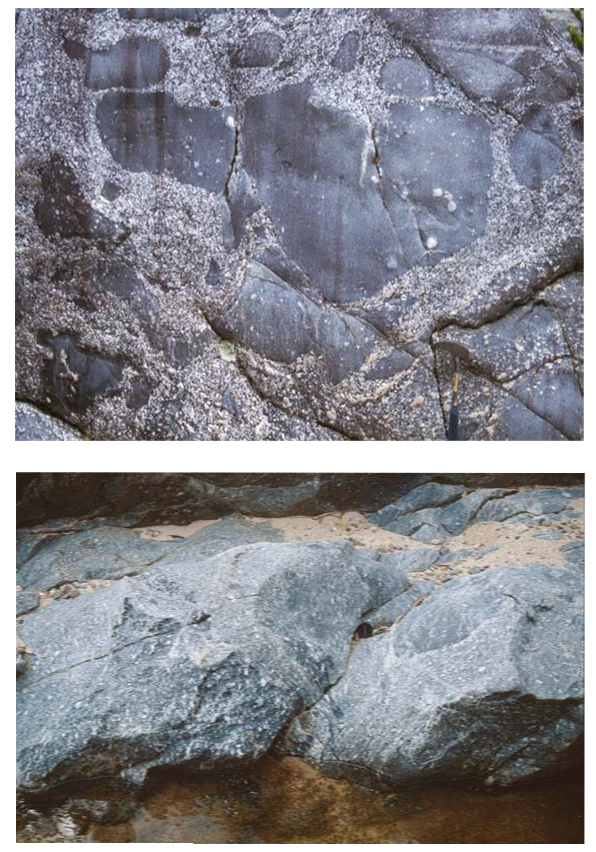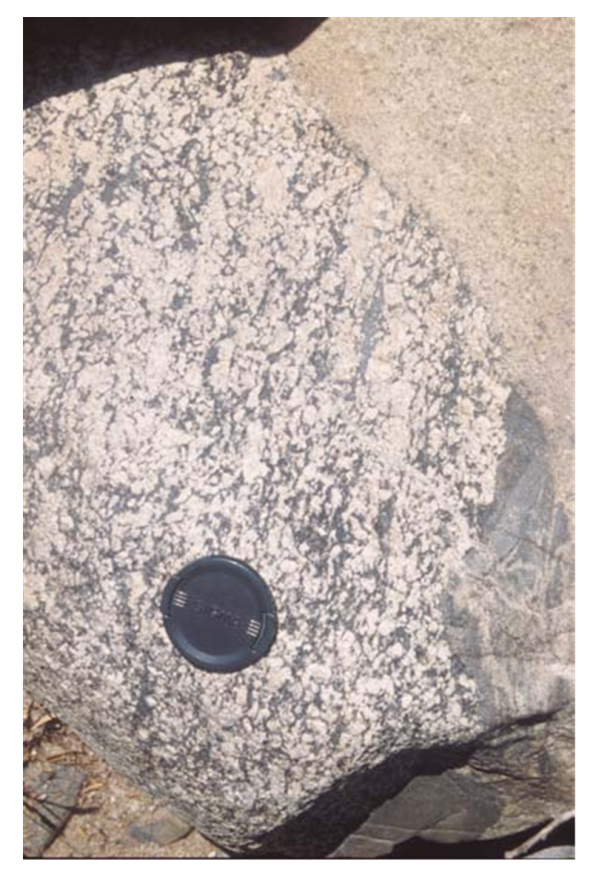Stop 6 - Kameruka–Basalt mixing
This dyke is flat-lying with irregular contacts, and as such, the boundaries are difficult to delineate. It is observed in the river as isolated, in situ outcrop among numerous transported granite boulders. The lower contact is a series of large, lobate, mafic enclaves with chilled bottoms, indicating "right way-up". The upper contact is a series of cm-scale, plagioclase-rich layers alternating with hornblende-rich layers, which locally form channel-structures and cross-beds. No detailed work has been carried out on this section so little is known about the absolute geometric and compositional relations.
This outcrop helps explain many of the charactistics of syn-magmatic mafic enclaves found in all Bega Batholith plutons but may also be applied to plutons worldwide. The most relevant feature for our purpose is the zone of interaction between gabbroic and crystal-rich Kameruka granite. There, cm-scale plagioclase and larger pseudomorphed K-feldspar grains (xenocrysts) from the Kameruka granite are dispersed through fine-grained gabbroic rock in wavy trails deformed by feldspar accumulations (Figure 20c). The trails range from clusters of feldspar to individual grains, all aligned parallel to each other, suggesting that it is a magmatic flow zone. Some of the trails emanate from larger clusters of feldspar resembling Kameruka granite, suggesting that granitic crystal mush and mafic magma co-existed in the same dyke.
Figure 20bc.

b) Mafic enclave in xenocryst-rich matrix within syn-plutonic dyke. c) Trails of pseudomorphous K-feldspar xenocrysts in hybrid dioritic matrix.
A less obvious mixing relation, but perhaps more important, is shown in Fig. 4.6.3. The rock is dominated by white feldspar, much of it pseudomorphed K-feldspar, aligned as a flow structure. The rock superficially resembles a granitic cumulate, but the matrix is fine grained mafic material rather than a felsic interstitial phase.
A few small mafic lenses resemble enclaves. The mafic material must have been a low viscosity liquid moving at relatively high flow rates to have permeated so effectively through the cumulate framework.
Commonly, small-scale "interstitial" mafic phases such as shown in Figure 20a are dispersed through granites. They are often overlooked because of their size, and perhaps because it is difficult to envisage how mafic material can permeate into and be dispersed through a granitic magma chamber. White and Chappell (1977) considered it to be restite, but the relations in Figure 20a is considered unequivocal evidence that basaltic magma and viscous crystal-rich granitic magma are capable of efficient mixing, but they have done so in a synplutonic dyke. Perhaps this is where efficient mixing occurs, but it is likely that subsequent flow of the hybrid dyke material into low viscosity granitic magma allow s for efficient dispersal through the chamber.
A final point from the outcrop: All the K-feldspar grains have been pseudomorphed by aggregates of sodic plagioclase and quartz, and are now xenocrysts in the synplutonic dykes. These xenocrysts, dispersed throughout fine-grained gabbroic material, closely resemble some of the xenocryst-rich hybrid zones found elsewhere in the Kameruka pluton. Does their presence in syn-plutonic dykes provide a general explanation for the origin of xenocryst-rich mafic enclaves? More evidence is presented at the next stop!
For a review on the mechanisms of enclave formation based in part on many of the outcrops we have visited see Collins, Richards, Healy and Ellison, 2000, Trans. Royal Soc. Edinburgh. 91 p 27-45.
